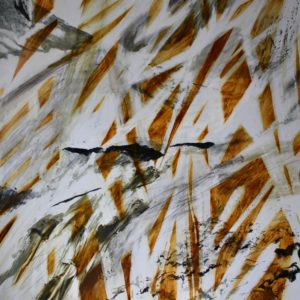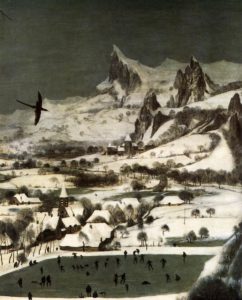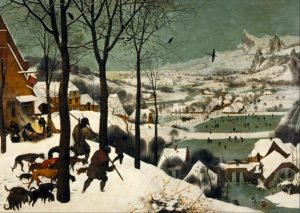
So here I am, in the studio, separated by a 1000 miles from the space and place I have visited, and disconnected by time, from those events by a month or so. Where to begin? Which event or walk should I start my artists/forensic investigations? Which drawings, photographs, rock samples do I review, mull over or print-out to aid my memory recall, to start piecing back together my mini-expedition?
In the book ‘What is Painting’ James Elkins writes about the Studio as a kind of psychosis...“Painting is Alchemy. Its materials are worked without knowledge of the properties, by blind experiment, by the feel of the pain” he goes on to say that“…painting is born in the smelly studio were the painter works in isolation, for hours or even years on end… the artist had to spend time shut up with oils and solvents, staring at glass or wooden surfaces, smeared with pigments, trying to smear them onto the surface in turn. Painting is peculiar in that respect. Writers and composers are much closer to the finished product: their words or notes appear instantly and cleaning on the page – there is no struggle forming the letters ABC or writing the notes – but painters have to work in morass of stubborn substances. For Those reasons the act of painting is a kind of insanity.”(James Elkins 1999: 9, 147)
He goes on to say, “Sooner or later every one of the painter’s possessions will get stained. First to go are the studio clothes and the old sneakers that get the full shower of paint every day. Next are the painters favourite books, the ones that have to be consulted in the studio. Then come the better clothes, one after another as they are worn just once into the studio and end up with the inevitable stain. The Last object to be stained is often the living room couch, one place where it is possible to relax in comfort and forget the studio. When the couch is stained, the painter has become a different creature from ordinary people, and there is no turning back”
and continues…
” Working in a studio means leaving the clean world of normal life moving into a shadowy domain when everything bears the marks of a singular obsession. Outside the studio, furniture is clean and comfortable; inside, it’s cold and unpleasant. Outside, the walls are monochrome or pleasantly patterned in wallpapered; inside, they are scarred with meaningless graffiti. Outside, floors can be mopped and vacuumed; inside, they build up layers of crusty paint that can only be scraped away or torn up with the floor itself. The studio is a necessary insanity. Perhaps writers have insanities of paper, or of the erasers, but they cannot compare with the multicoloured dementia caused by fluids and stone.” (James Elkins 1999: 148, 149)
Once I am back home from my travels, I do not start painting immediately, I reflect on the various walks and consider those that had a particular resonance and stuck with me. That may be to do with height gain, distance, the weather or the geomorphology, or it may be to so with something small or feature, an ice bridge of rock fall, a wall of scree. I shall remember, visualizing a walk, thinking about the various changes of textures, colours, light and forms. If I found a particularly interesting rock on a walk that I picked up, I shall touch and study it, turning it over in my hands and examining the colours within whilst thinking about the walk.
These rocks become visual reference aids, helping me to visualise the nuances for a location, making it more tangible and real, rather than simply looking at a series of single viewpoint photographs, which to some extent, are false recording of the space, as I have already mentioned, distorting the perspective, colours and lacking any sense of the emotional and visceral experience.
In a recent paper by Laura Donker entitled Drawing: Knowledge as Process at a drawing symposium in Plymouth (an artist and ecologies who lives on North Uist of how her artistic engagement with the landscape is a physical one, working ‘in’ the landscape rather than ‘in’ the studio) she states, “My process of drawing does not seek to create pictures of my seeing but is about finding a way to really see what I’m looking at. A face-to-face encounter with the substance of place, and how I just my gaze and my perception, only when I’m caught up subconsciously in action of ‘coming to see’: A blind engagement that gains sight as the drawing progresses.”
It is only then that I start to focus on a location and search out those images related to that site or space. These are not just images of one subject or place, but images that are taken at stages along a route, path and walk. This often includes images taken on the return journey, when the lighting conditions have changed, as the Earth has changed its position relative to the Sun and the Sun appears higher or lower in the sky.
I will then print out a selection of images both in colour and black and white, sometimes printing them out onto acetates and overlaying them, cutting sections from one image and adding it to another or drawing and painting over the top of an image or underneath an acetate to making a series of collages, creating hybrid space, and the beginnings of something that may begin to resonate with me about a walk or space. This becomes a way of moving from the photographic depiction and allow me to visually collage my memories to capture an essence of aspects of a walk or location, similar in a way to the way Richter worked by blurring his works. I will also surround myself in the studio itself with images, images of the same walk, which in some way acts as a form of virtual view, akin to my prereferral vision during the walk.
This use of collage and manipulating the scene is not new, Pieter Bruegel's (1525-1530 – 1569) painting, 'Hunters in the Snow' which includes a vast mountain range in the background something not found in Holland and therefore defiantly not a typical Dutch landscape. Bruegel has superimposed an imagery expanse of cliff-faces and sharp peaks, a memory after a visit to the Alps.


https://commons.wikimedia.org/wiki/File:Pieter_Bruegel_the_Elder_-_Hunters_in_the_Snow_(Winter)_-_Google_Art_Project.jpg

